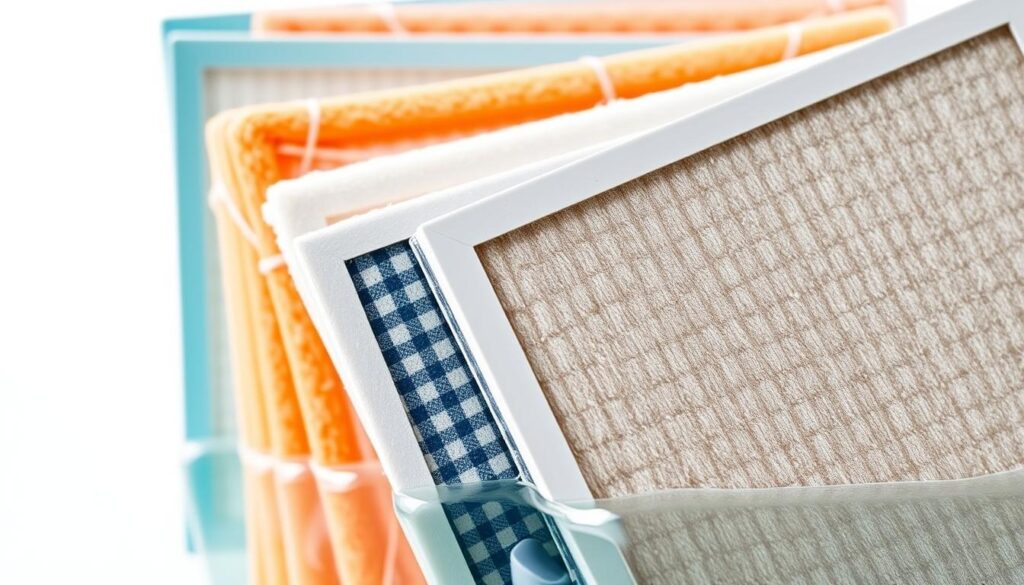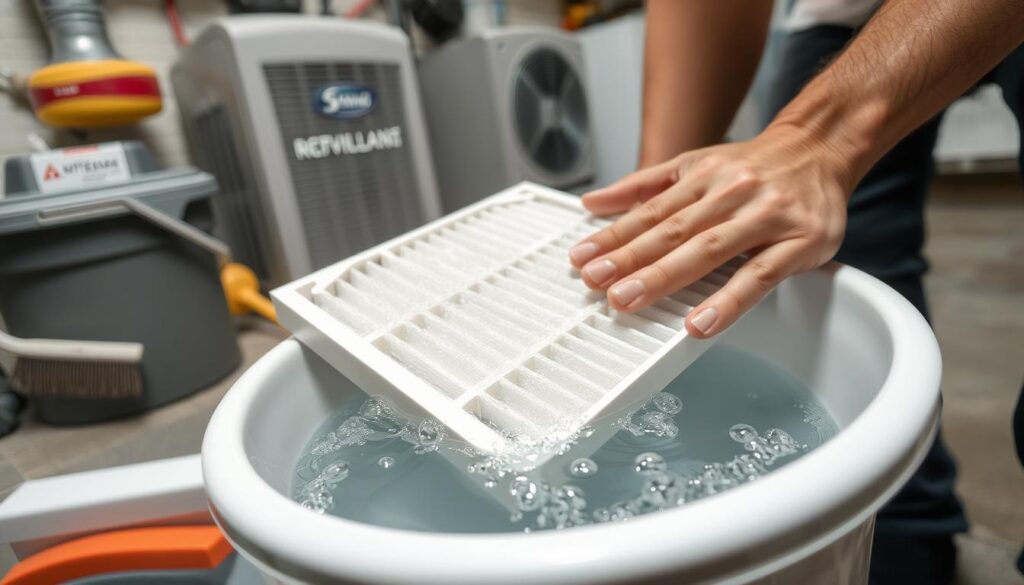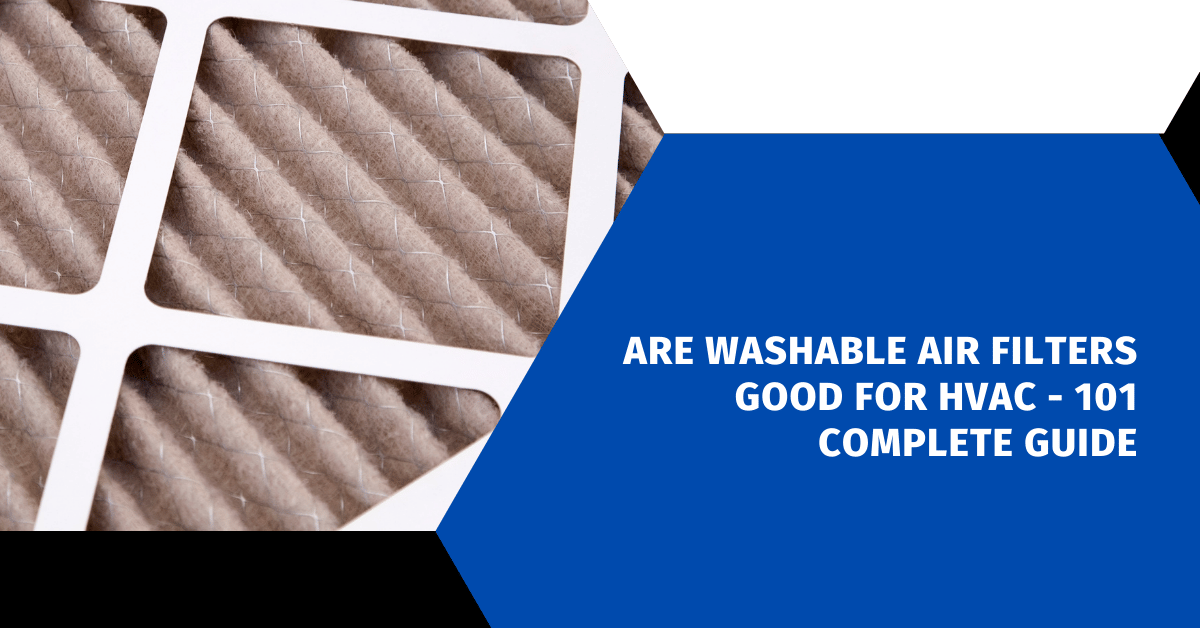Affiliate Disclosure
HVAC Guide Guys is a participant in the Amazon Services LLC Associates Program, an affiliate advertising program designed to provide a means for sites to earn advertising fees by advertising and linking to Amazon.
Are Washable Air Filters Good for HVAC? Ever thought about using washable air filters for your HVAC system? With so many choices, picking the best one can be tough. This guide will help you understand the pros and cons of washable air filters for your HVAC. You’ll learn how to keep your air clean and your system running smoothly.

Key Takeaways
- HVAC air filters are measured by the MERV rating, with higher numbers indicating better trapping of small particles.
- Washable air filters can be more cost-effective in the long run but may have lower MERV ratings compared to disposable filters.
- Proper maintenance is crucial for washable filters to ensure optimal performance and avoid mold growth.
- Choosing the right MERV rating for your home depends on factors like allergies, pets, and local air quality.
- Weighing the benefits and drawbacks of washable vs. disposable filters is essential to make an informed decision.
Table of Contents
Understanding HVAC Air Filter Basics
Air filtration is key to a healthy and efficient HVAC system. It removes dust, pollen, and pet dander. This improves indoor air quality and protects your HVAC system.
The Purpose of HVAC Filtration
Air filters are the first defense against airborne particles. They trap dust and pollen, preventing them from harming your home. This keeps your HVAC system running smoothly and efficiently.
How Air Filters Protect Your HVAC System
Without air filters, dust and pollen can damage your HVAC system. Dirty filters make it work harder, using more energy. This can shorten your system’s life.
Different Types of Air Filter Materials
HVAC air filters are made from various materials. You can find fiberglass, cotton, plastic fibers, and synthetic materials. Fiberglass filters are cheap but not very effective.
Pleated filters, made from cotton or plastic, have more surface area. This means they can catch more particles. Washable filters use a special material to attract and trap particles. HEPA filters are the most effective, capturing up to 99.97% of particles as small as 0.3 microns.
“Regularly replacing dirty air filters can lower AC energy consumption by up to 15%, depending on factors such as home size, number of pets, time of year, and HVAC system usage.”
Explore Our HVAC Shop
Looking for top-rated HVAC tools, parts, and accessories? Visit our shop and find the perfect solution for your needs.
Visit the ShopAre Washable Air Filters Good for HVAC
Choosing between washable and disposable air filters affects your HVAC system’s efficiency and cost. Washable filters have their pros and cons for homes and businesses.
Washable filters last 5-10 years with care, saving money and the environment. They’re also good for the planet since you don’t need to replace them often. This reduces waste and supports sustainable HVAC practices.
But, these filters catch fewer small particles like dust and pollen. This can lower indoor air quality and affect your HVAC’s performance. Disposable filters, on the other hand, can filter out more with higher MERV ratings.
| Feature | Washable Air Filters | Disposable Air Filters |
|---|---|---|
| Average Cost | $75 | $15 |
| Lifespan | 5-10 years | 30-90 days |
| MERV Rating | 1-4 | 4-16 |
| Filtration Efficiency | Under 75% of larger particles | Up to 95% of larger particles |
The electrostatic charge in washable filters weakens over time. This can lower their effectiveness. It’s crucial to clean and dry them well to avoid mold and keep them working well.
In conclusion, washable filters save money and are eco-friendly but might not filter as well as disposable ones. Your choice should depend on your HVAC needs, budget, and preferences.
Explore Our HVAC Shop
Looking for top-rated HVAC tools, parts, and accessories? Visit our shop and find the perfect solution for your needs.
Visit the ShopBenefits of Washable HVAC Filters
Choosing between disposable and washable air filters affects your HVAC system’s upkeep costs and the environment. Washable reusable air filters are a great option. They offer cost-effective HVAC maintenance and are eco-friendly.
Long-Term Cost Savings
Washable HVAC filters can save you money in the long run. They cost between $50 and $60, which might seem expensive at first. But, they can last up to 10 years with care, saving you from buying new filters often.
This can lead to big savings over time. It’s especially true when you compare it to the cost of disposable filters, which you need to buy every few months.
Environmental Impact
Using reusable air filters helps reduce waste from disposable filters. These filters are made to be cleaned and used again. This cuts down on the waste from making and throwing away single-use filters.
This approach supports eco-friendly filtration and sustainable home choices.
Durability and Lifespan
Washable HVAC filters are also durable and long-lasting. They’re made from materials like aluminum mesh or synthetic fibers. These materials can handle cleaning and reuse well.
With regular cleaning, like vacuuming or rinsing, these filters can filter air effectively for years. This makes them a smart choice for cost-effective HVAC maintenance over time.
“Investing in a washable HVAC filter can pay dividends in the long run, both financially and environmentally.”
Limitations and Drawbacks of Washable Filters
Washable air filters have some good points, but they also have downsides. One big issue is their lower washable filter efficiency compared to disposable filters. They usually have MERV ratings from 1 to 4. This means they catch fewer small particles like dust and some allergens.
Another problem is that their filtration power can drop over time. The electrostatic charge that catches particles weakens. This makes it harder for the filter to keep the air clean. It’s important to clean and dry the filter well to avoid mold and bacteria growth.
Cleaning the filter takes time and effort. It must be dry before you put it back in. If it’s not, it can harm the HVAC system. Also, over time, the filter can get clogged. This can slow down airflow and make the system less efficient.
| Limitation | Description |
|---|---|
| Lower MERV Ratings | Washable filters typically have MERV ratings between 1-4, making them less efficient at capturing smaller particles compared to disposable filters. |
| Decreased Filtration Efficiency | The electrostatic charge that helps trap particles can diminish over time, reducing the filter’s ability to effectively remove contaminants. |
| Mold and Bacteria Growth | If not cleaned and dried thoroughly, washable filters can become breeding grounds for mold and bacteria, compromising indoor air quality. |
| Clogging and Airflow Restrictions | Washable filters can become clogged with debris over time, potentially affecting HVAC system airflow and efficiency. |
Washable filters might save money in the long run. But, homeowners need to consider the trade-offs. They must also make sure to maintain them well. This keeps the washable filter efficiency and HVAC system working right.
Explore Our HVAC Shop
Looking for top-rated HVAC tools, parts, and accessories? Visit our shop and find the perfect solution for your needs.
Visit the ShopMERV Ratings Explained
Choosing the right air filter for your HVAC system is key. The MERV (Minimum Efficiency Reporting Value) rating is important. It ranges from 1 to 16, with higher numbers meaning better filtration.
Knowing how these ratings work helps you pick the best filter for your space.
Understanding Filtration Efficiency
The MERV rating shows how well an air filter catches airborne particles. Lower MERV ratings (1-4) catch big particles like dust and pollen. Medium ratings (5-8) trap smaller stuff like mold spores and pet dander.
Higher ratings (9-16) can even catch tiny particles, including bacteria and smoke.
Choosing the Right MERV Rating
The right MERV rating for your HVAC depends on several things. These include your air quality needs, the environment, and your equipment’s limits. Most homes do well with a MERV rating between 7 and 12.
Places needing very clean air, like medical facilities, might need a MERV rating of 13 or higher.
Impact on HVAC Performance
Higher MERV rated filters can make your HVAC system work harder. This might make it less efficient. Filters rated above 12 might not be good for all home systems.
They could use more energy and even damage your equipment. Finding the right balance between good filtration and system compatibility is key.
Understanding the MERV rating system helps you choose the right filter. This ensures your HVAC system works well and keeps the air clean. Talk to a professional to find the best MERV rating for your HVAC and environment.
Maintenance Requirements for Washable Filters
Keeping your washable air filters in top shape is key for your HVAC system’s best performance. Unlike disposable filters, washable ones need regular cleaning and care to work well.
Experts say you should clean your washable filters every one to three months. This depends on your home’s size, pets, and air pollution levels. Start by gently vacuuming or shaking off debris, then rinse with clean water. Make sure the filter dries completely, which takes 20-30 minutes, to avoid mold and bacteria.
Even with regular cleaning, particles can get stuck deep in the filter media. This can block airflow and lower the filter’s efficiency. Also, the electrostatic charge that catches small particles may weaken with each wash.
- Reusable air filters should be cleaned every 90 days for the average home.
- For larger homes, allergy sufferers, or households with pets, the filter should be cleaned every one to two months or when visibly dirty.
- Washable filters can have a MERV rating between one and four, but higher-rated options may be available.
Washable filters can last 5-10 years with good HVAC maintenance. But, they’ll need to be replaced when they start to perform poorly. By following the manufacturer’s filter care guidelines, your HVAC system will keep running efficiently and your indoor air quality will stay good.

Explore Our HVAC Shop
Looking for top-rated HVAC tools, parts, and accessories? Visit our shop and find the perfect solution for your needs.
Visit the ShopCost Comparison: Washable vs. Disposable Filters
Choosing between washable and disposable HVAC air filters depends on the initial cost and long-term savings. Washable filters cost more upfront, between $25 to $75. Yet, they offer big savings over time compared to disposable filters.
Initial Investment Analysis
Disposable air filters cost about $15 each. They must be replaced every 2 to 3 months, costing $60 to $90 a year. On the other hand, a washable filter can last 5 to 10 years with care, making the initial cost worthwhile in the long run.
Long-term Financial Benefits
Washable filters save money over time. Although they cost more at first, the savings add up, especially with less waste and better environmental impact. They also help your HVAC system work more efficiently, saving energy and more money.
| Filter Type | Initial Cost | Lifespan | Annual Cost | 10-Year Cost |
|---|---|---|---|---|
| Disposable | $15 per filter | 2-3 months | $60 – $90 | $600 – $900 |
| Washable | $25 – $75 | 5-10 years | $5 – $15 | $50 – $150 |
The choice between washable and disposable filters depends on your budget and needs. But, washable filters offer significant long-term savings. They are worth considering for HVAC filter costs and air filter comparison to find long-term savings.
Choosing the Right Filter for Your System
Choosing the right HVAC filter is key to keeping your system running well and improving air quality indoors. You need to think about your specific needs, the air quality in your area, and if the filter fits your HVAC system.
If allergies are a problem, a higher MERV rating, between 9 and 12, can help catch more allergens. Homes with pets should use at least a MERV 5-8 filter to trap pet dander and hair.
In areas with lots of air pollution, a MERV 11-13 filter can capture smaller particles for better filtration. But, make sure your HVAC system can handle the airflow restriction from higher MERV ratings. A duct static pressure test can help determine if your system can accommodate a high-efficiency filter.
Think about how often you’ll need to clean or replace the filter. Washable filters save money in the long run but might need more cleaning. Disposable filters, on the other hand, need to be replaced every 1-3 months, depending on how often you use them and the filter’s MERV rating.
To find the best HVAC filter, balance how well it filters, if it fits your system, and how easy it is to maintain. This will help your system work its best and improve the air quality in your home.

“Regularly replacing dirty and clogged filters can prevent HVAC equipment breakdowns.”
Conclusion
Choosing between washable and disposable air filters for your HVAC system is a big decision. You need to think about your needs, what’s important to you, and what your heating and cooling system needs. Washable filters save money and are good for the environment, but they might not filter as well as disposable ones.
Disposable filters, however, come in many MERV ratings and are easy to use. But, they cost money every time you need to replace them.
When picking an HVAC filter, think about the upfront cost, long-term expenses, upkeep, and how it affects your air quality. Talking to a skilled HVAC technician can help you find the right filter for your system, air quality goals, and efficiency needs.
In the end, picking between washable and disposable filters is about finding a balance. You want to make sure your HVAC system works well, your air is clean, and you’re not spending too much. By looking at the good and bad of each, you can choose wisely. This way, you’ll keep your HVAC system healthy, consider the environment, and stay within your budget.

